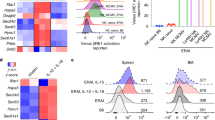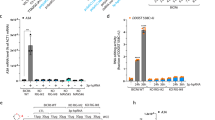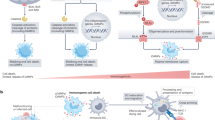Abstract
MICA and MICB are stress-induced ligands recognized by the activating receptor NKG2D. A microRNA encoded by human cytomegalovirus downregulates MICB expression by targeting a specific site in the MICB 3′ untranslated region. As this site is conserved among different MICB alleles and a similar site exists in the MICA 3′ untranslated region, we speculated that these sites are targeted by cellular microRNAs. Here we identified microRNAs that bound to these MICA and MICB 3′ untranslated region sequences and obtained data suggesting that these microRNAs maintain expression of MICA and MICB protein under a certain threshold and facilitate acute upregulation of MICA and MICB during cellular stress. These microRNAs were overexpressed in various tumors and we demonstrate here that they aided tumor avoidance of immune recognition.
This is a preview of subscription content, access via your institution
Access options
Subscribe to this journal
Receive 12 print issues and online access
$209.00 per year
only $17.42 per issue
Buy this article
- Purchase on Springer Link
- Instant access to full article PDF
Prices may be subject to local taxes which are calculated during checkout







Similar content being viewed by others
References
Du, T. & Zamore, P.D. microPrimer: the biogenesis and function of microRNA. Development 132, 4645–4652 (2005).
Ambros, V. The functions of animal microRNAs. Nature 431, 350–355 (2004).
Lewis, B.P., Burge, C.B. & Bartel, D.P. Conserved seed pairing, often flanked by adenosines, indicates that thousands of human genes are microRNA targets. Cell 120, 15–20 (2005).
Cho, W.C. OncomiRs: the discovery and progress of microRNAs in cancers. Mol. Cancer 6, 60 (2007).
He, L. et al. A microRNA polycistron as a potential human oncogene. Nature 435, 828–833 (2005).
Dews, M. et al. Augmentation of tumor angiogenesis by a Myc-activated microRNA cluster. Nat. Genet. 38, 1060–1065 (2006).
Huang, Q. et al. The microRNAs miR-373 and miR-520c promote tumour invasion and metastasis. Nat. Cell Biol. 10, 202–210 (2008).
Lodish, H.F., Zhou, B., Liu, G. & Chen, C.Z. Micromanagement of the immune system by microRNAs. Nat. Rev. Immunol. 8, 120–130 (2008).
Eagle, R.A. & Trowsdale, J. Promiscuity and the single receptor: NKG2D. Nat. Rev. Immunol. 7, 737–744 (2007).
Gasser, S. & Raulet, D.H. Activation and self-tolerance of natural killer cells. Immunol. Rev. 214, 130–142 (2006).
Groh, V., Steinle, A., Bauer, S. & Spies, T. Recognition of stress-induced MHC molecules by intestinal epithelial γδ T cells. Science 279, 1737–1740 (1998).
Venkataraman, G.M., Suciu, D., Groh, V., Boss, J.M. & Spies, T. Promoter region architecture and transcriptional regulation of the genes for the MHC class I-related chain A and B ligands of NKG2D. J. Immunol. 178, 961–969 (2007).
Groh, V. et al. Cell stress-regulated human major histocompatibility complex class I gene expressed in gastrointestinal epithelium. Proc. Natl. Acad. Sci. USA 93, 12445–12450 (1996).
Boissel, N. et al. BCR/ABL oncogene directly controls MHC class I chain-related molecule A expression in chronic myelogenous leukemia. J. Immunol. 176, 5108–5116 (2006).
Nedvetzki, S. et al. Reciprocal regulation of human natural killer cells and macrophages associated with distinct immune synapses. Blood 109, 3776–3785 (2007).
Stern-Ginossar, N. et al. Host immune system gene targeting by a viral miRNA. Science 317, 376–381 (2007).
Landais, S., Landry, S., Legault, P. & Rassart, E. Oncogenic potential of the miR-106–363 cluster and its implication in human T-cell leukemia. Cancer Res. 67, 5699–5707 (2007).
Voorhoeve, P.M. et al. A genetic screen implicates miRNA-372 and miRNA-373 as oncogenes in testicular germ cell tumors. Cell 124, 1169–1181 (2006).
Skalsky, R.L. et al. Kaposi's sarcoma-associated herpesvirus encodes an ortholog of miR-155. J. Virol. 81, 12836–12845 (2007).
Gottwein, E. et al. A viral microRNA functions as an orthologue of cellular miR-155. Nature 450, 1096–1099 (2007).
Lee, Y. et al. The nuclear RNase III Drosha initiates microRNA processing. Nature 425, 415–419 (2003).
Lewis, B.P., Shih, I.H., Jones-Rhoades, M.W., Bartel, D.P. & Burge, C.B. Prediction of mammalian microRNA targets. Cell 115, 787–798 (2003).
Landgraf, P. et al. A mammalian microRNA expression atlas based on small RNA library sequencing. Cell 129, 1401–1414 (2007).
Meister, G., Landthaler, M., Dorsett, Y. & Tuschl, T. Sequence-specific inhibition of microRNA- and siRNA-induced RNA silencing. RNA 10, 544–550 (2004).
Cosman, D. et al. ULBPs, novel MHC class I-related molecules, bind to CMV glycoprotein UL16 and stimulate NK cytotoxicity through the NKG2D receptor. Immunity 14, 123–133 (2001).
Groh, V. et al. Costimulation of CD8αβ T cells by NKG2D via engagement by MIC induced on virus-infected cells. Nat. Immunol. 2, 255–260 (2001).
Gasser, S., Orsulic, S., Brown, E.J. & Raulet, D.H. The DNA damage pathway regulates innate immune system ligands of the NKG2D receptor. Nature 436, 1186–1190 (2005).
Mocarski, E.S. Jr. Immune escape and exploitation strategies of cytomegaloviruses: impact on and imitation of the major histocompatibility system. Cell. Microbiol. 6, 707–717 (2004).
Jonjic, S., Babic, M., Polic, B. & Krmpotic, A. Immune evasion of natural killer cells by viruses. Curr. Opin. Immunol. 20, 30–38 (2008).
Grey, F. et al. Identification and characterization of human cytomegalovirus-encoded microRNAs. J. Virol. 79, 12095–12099 (2005).
Andresen, L., Jensen, H., Pedersen, M.T., Hansen, K.A. & Skov, S. Molecular regulation of MHC class I chain-related protein A expression after HDAC-inhibitor treatment of Jurkat T cells. J. Immunol. 179, 8235–8242 (2007).
Diefenbach, A., Jamieson, A.M., Liu, S.D., Shastri, N. & Raulet, D.H. Ligands for the murine NKG2D receptor: expression by tumor cells and activation of NK cells and macrophages. Nat. Immunol. 1, 119–126 (2000).
Wiemann, K. et al. Systemic NKG2D down-regulation impairs NK and CD8 T cell responses in vivo. J. Immunol. 175, 720–729 (2005).
Gazit, R. et al. Lethal influenza infection in the absence of the natural killer cell receptor gene Ncr1. Nat. Immunol. 7, 517–523 (2006).
Hornstein, E. & Shomron, N. Canalization of development by microRNAs. Nat. Genet. 38 Suppl, S20–S24 (2006).
Varghese, J. & Cohen, S.M. microRNA miR-14 acts to modulate a positive autoregulatory loop controlling steroid hormone signaling in Drosophila. Genes Dev. 21, 2277–2282 (2007).
Stark, A., Brennecke, J., Bushati, N., Russell, R.B. & Cohen, S.M. Animal MicroRNAs confer robustness to gene expression and have a significant impact on 3′UTR evolution. Cell 123, 1133–1146 (2005).
Vasudevan, S., Tong, Y. & Steitz, J.A. Switching from repression to activation: microRNAs can up-regulate translation. Science 318, 1931–1934 (2007).
Leung, A.K. & Sharp, P.A. microRNAs: a safeguard against turmoil? Cell 130, 581–585 (2007).
Diefenbach, A., Jensen, E.R., Jamieson, A.M. & Raulet, D.H. Rae1 and H60 ligands of the NKG2D receptor stimulate tumour immunity. Nature 413, 165–171 (2001).
Hayakawa, Y. & Smyth, M.J. NKG2D and cytotoxic effector function in tumor immune surveillance. Semin. Immunol. 18, 176–185 (2006).
Guerra, N. et al. NKG2D-deficient mice are defective in tumor surveillance in models of spontaneous malignancy. Immunity 28, 571–580 (2008).
Groh, V., Wu, J., Yee, C. & Spies, T. Tumour-derived soluble MIC ligands impair expression of NKG2D and T-cell activation. Nature 419, 734–738 (2002).
Doubrovina, E.S. et al. Evasion from NK cell immunity by MHC class I chain-related molecules expressing colon adenocarcinoma. J. Immunol. 171, 6891–6899 (2003).
Xu, K., Ma, H., McCown, T.J., Verma, I.M. & Kafri, T. Generation of a stable cell line producing high-titer self-inactivating lentiviral vectors. Mol. Ther. 3, 97–104 (2001).
Kafri, T., Blomer, U., Peterson, D.A., Gage, F.H. & Verma, I.M. Sustained expression of genes delivered directly into liver and muscle by lentiviral vectors. Nat. Genet. 17, 314–317 (1997).
Shi, R. & Chiang, V.L. Facile means for quantifying microRNA expression by real-time PCR. Biotechniques 39, 519–525 (2005).
Wolf, D.G. et al. Emergence of late cytomegalovirus central nervous system disease in hematopoietic stem cell transplant recipients. Blood 101, 463–465 (2003).
Skov, S. et al. Cancer cells become susceptible to natural killer cell killing after exposure to histone deacetylase inhibitors due to glycogen synthase kinase-3-dependent expression of MHC class I-related chain A and B. Cancer Res. 65, 11136–11145 (2005).
Mandelboim, O. et al. Protection from lysis by natural killer cells of group 1 and 2 specificity is mediated by residue 80 in human histocompatibility leukocyte antigen C alleles and also occurs with empty major histocompatibility complex molecules. J. Exp. Med. 184, 913–922 (1996).
Acknowledgements
We thank D. Cosman (Amgen) for the NKG2D-Ig constructs and A. Bernard (Hôpital de L'Archet) for anti-CD99. Supported by the United States–Israel Binational Science Foundation (O.M.), the Israeli Cancer Research Foundation (O.M.), the Israeli Science Foundation (O.M.), the European Consortium (MRTN-CT-2005 and LSCH-CT-2005-518178 to O.M.), the Association for International Cancer Research (O.M.) and the Israel Academy of Sciences and Humanities (Adams Fellowship to N.S.-G.).
Author information
Authors and Affiliations
Contributions
N.S.-G. designed and did the experiments; C.G. helped with mouse experiments; M.B., E.H., M.E., N.S. and M.M. provided reagents; O.M. designed the experiments and supervised the project; and N.S.-G. and O.M. analyzed the results and wrote the paper.
Corresponding author
Supplementary information
Supplementary Text and Figures
Supplementary Figures 1–4, Table 1 and Methods (PDF 557 kb)
Rights and permissions
About this article
Cite this article
Stern-Ginossar, N., Gur, C., Biton, M. et al. Human microRNAs regulate stress-induced immune responses mediated by the receptor NKG2D. Nat Immunol 9, 1065–1073 (2008). https://doi.org/10.1038/ni.1642
Received:
Accepted:
Published:
Issue Date:
DOI: https://doi.org/10.1038/ni.1642
This article is cited by
-
KLF4-mediated upregulation of the NKG2D ligand MICA in acute myeloid leukemia: a novel therapeutic target identified by enChIP
Cell Communication and Signaling (2023)
-
Novel role of immune-related non-coding RNAs as potential biomarkers regulating tumour immunoresponse via MICA/NKG2D pathway
Biomarker Research (2023)
-
p53 and HuR combinatorially control the biphasic dynamics of microRNA-125b in response to genotoxic stress
Communications Biology (2023)
-
MicroRNAs expressed by human cytomegalovirus
Virology Journal (2020)
-
The role of cancer-derived microRNAs in cancer immune escape
Journal of Hematology & Oncology (2020)



